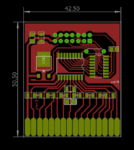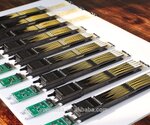Prabhakarankft
Member level 3
- Joined
- Jun 22, 2019
- Messages
- 54
- Helped
- 0
- Reputation
- 0
- Reaction score
- 4
- Trophy points
- 8
- Location
- Chennai, India
- Activity points
- 623
Hello Everyone! Greetings!
I am having one Small PCB Board which is used to actuate the solenoids.. We will install in a solenoid and too many solenoids will be used for our field application.
Circuit is very simple. We are getting power and signals from Ribbon cables and in a single ribbon cable we will connect 16 PCB boards one by one( daisy Chain- 74HC595 IC used)
Input voltage: 15VDC
Voltage regulator: 78M05(1A SMD regulator)
Logical IC : 74HC595D(Nexperia)
Current Driver: ULN2803FWG( Thosiba)
Problem:
Sometimes 10uF/25V capacitor is started to burn and creates big flame. We using this capacitor across the input power supply. Since We using 15VDC as power supply My component vendor suggested to buy TMK316BJ106KL part...
Make: Taio yuden from Germany.. We ran a test at my supplier office the capacitor is withstanding up to 28VDC. We have tested this for 25 minutes continuously..
Capacitor rated voltage is 25VDC.. Is this enough for our application? Or any other reverse voltage from solenoids disturbing the capacitor? Out of 1000 boards 100 boards getting the same issue
Can anyone tell me if there is any SMD capacitor comes with 10uF/35V rating.?? I have heard that increasing the rated voltage of capacitor will solve this issue..
As per the input voltage Rated voltage 25VDC is correct selection I think. Capacitor should be 1.5 times higher than the input voltage.. Correct me if I am Wrong.

Some people are saying this is due to Soldering issue?? Expecting good guidance
I am having one Small PCB Board which is used to actuate the solenoids.. We will install in a solenoid and too many solenoids will be used for our field application.
Circuit is very simple. We are getting power and signals from Ribbon cables and in a single ribbon cable we will connect 16 PCB boards one by one( daisy Chain- 74HC595 IC used)
Input voltage: 15VDC
Voltage regulator: 78M05(1A SMD regulator)
Logical IC : 74HC595D(Nexperia)
Current Driver: ULN2803FWG( Thosiba)
Problem:
Sometimes 10uF/25V capacitor is started to burn and creates big flame. We using this capacitor across the input power supply. Since We using 15VDC as power supply My component vendor suggested to buy TMK316BJ106KL part...
Make: Taio yuden from Germany.. We ran a test at my supplier office the capacitor is withstanding up to 28VDC. We have tested this for 25 minutes continuously..
Capacitor rated voltage is 25VDC.. Is this enough for our application? Or any other reverse voltage from solenoids disturbing the capacitor? Out of 1000 boards 100 boards getting the same issue
Can anyone tell me if there is any SMD capacitor comes with 10uF/35V rating.?? I have heard that increasing the rated voltage of capacitor will solve this issue..
As per the input voltage Rated voltage 25VDC is correct selection I think. Capacitor should be 1.5 times higher than the input voltage.. Correct me if I am Wrong.

Some people are saying this is due to Soldering issue?? Expecting good guidance



